Build Design Systems With Penpot Components
Penpot's new component system for building scalable design systems, emphasizing designer-developer collaboration.

medium bookmark / Raindrop.io |
The scandal hitting Facebook today has been in the works for years. With or without Cambridge Analytica, Facebook was collecting a lot of information about you, sharing it too liberally with outside apps, and ultimately disguising all this behavior with “user-friendly” dark patterns.
Facebook has already announced some new policies and updates, but the response from Zuckerberg has run along the lines of “we’re fixing it, but this will take years.” With 2 billion people across the world, it’s complicated. It will take time. Still, when we challenged San Francisco design firm NewDealDesign to design a more transparent and honest Facebook, its designers–known for its products made for Google, Intel, and Fitbit–fixed some of the social network’s biggest problems in less than a week. Indeed, it’s easier to be nimble outside a company than inside it.
The work, overseen by studio head Gadi Amit, was completed by UX designers Timmy Chau, Angelica Cupat, and Eliza Tehan. Their concept still looks like the same old Facebook you already know–just better. So let’s walk through each of its four components, one at a time.
[Image: courtesy NewDealDesign]
Right now, when Facebook apps request access to your information, it’s generally posed an ultimatum: “Give us all the data we’re asking for, or don’t use us at all.” And historically, that data could be dipped into, and copied, whenever an app wanted (though Facebook is discontinuing at least some of that access to older and shadier apps).
NDD suggests a few changes to this model. On the back end, Facebook should hold all of the information securely, but share only what is needed when it’s needed. It should also force all app developers into agreements that promise they don’t save your data on their own servers. This sounds like it’s as much a technology problem as an accountability problem. Facebook would likely have to invest in both.
On the front end, NDD suggests other changes to inform and empower the user. When you’re logging into an app through Facebook for the first time–that moment where you agree to let an app to access your data–the notification should be more complicated, not less.
“Right now when you sign through Facebook, they give you this general screen, ‘use Facebook to sign in and continue,’” says Chau. “They get your personal info and friends list, but because you’re mentally like, ‘let’s do this.’ But what if we could reveal this information?”
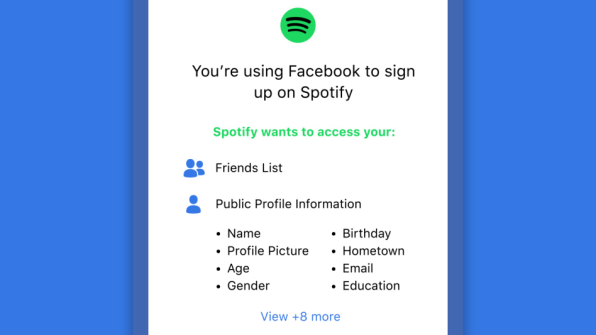 [Image: courtesy NewDealDesign]NDD’s redesign includes a more specific breakdown of what the app sees, and how the app plans to use your data. Crucially, by hitting a single check mark, you can also opt to use every app with a new option: identity verification. This option would empower you to share nothing at all with a third-party company. It would simply verify that you are who you say you are through Facebook. “Why can’t these platforms let me use Facebook login at a base minimum without sharing information at all?” asks Chau. “Facebook will just say, ‘yes this person exists,’ rather than letting an app see everything about you and your friends, forever.”[Image: courtesy NewDealDesign]
[Image: courtesy NewDealDesign]NDD’s redesign includes a more specific breakdown of what the app sees, and how the app plans to use your data. Crucially, by hitting a single check mark, you can also opt to use every app with a new option: identity verification. This option would empower you to share nothing at all with a third-party company. It would simply verify that you are who you say you are through Facebook. “Why can’t these platforms let me use Facebook login at a base minimum without sharing information at all?” asks Chau. “Facebook will just say, ‘yes this person exists,’ rather than letting an app see everything about you and your friends, forever.”[Image: courtesy NewDealDesign]
When she was in middle school, Cupat took a silly quiz on Facebook. But it wasn’t until she checked her connected apps in the wake of the Cambridge Analytica scandal that she realized something: That silly quiz app, with terms and conditions agreed to in her teens, was still tracking her into her 20s.
Facebook lets you check which apps are connected to your account, but it’s impossible to see who accessed what, or when. NDD suggests that Facebook put simple reminders about which apps are accessing your information into your feed on a regular basis. “What if every so often, Facebook tells you, ‘Hey, you’re sharing this information, do you want to check this out?’” says Amit, adding that it could happen on a monthly basis.
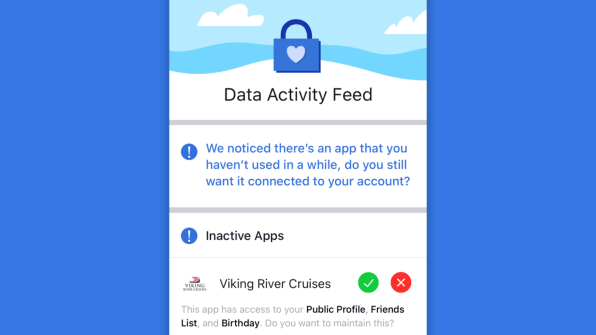 [Image: courtesy NewDealDesign]Then, if the user wants to go even deeper, the team imagines something even better: a “Data Activity Feed.” Much like the Facebook feed you know, this feed would have updates from all the apps pinging your account. It would list the information they request, and if you want to remove the app after seeing what it’s doing? You hit an X right in the feed, and it’s terminated.
[Image: courtesy NewDealDesign]Then, if the user wants to go even deeper, the team imagines something even better: a “Data Activity Feed.” Much like the Facebook feed you know, this feed would have updates from all the apps pinging your account. It would list the information they request, and if you want to remove the app after seeing what it’s doing? You hit an X right in the feed, and it’s terminated.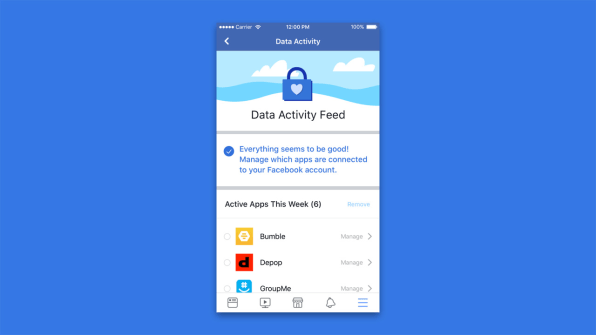 Data Activity Feed [Image: courtesy NewDealDesign]
Data Activity Feed [Image: courtesy NewDealDesign]
A lot of people don’t realize that when you type a personal bit of information into Facebook Messenger, Facebook saves those messages by default. Of course, the company may do this to allow you to reference your messages easily from any device. But it’s the perfect example of one of those creepy-if-you-consider-it things that Facebook could use design to mitigate and explain to its users.
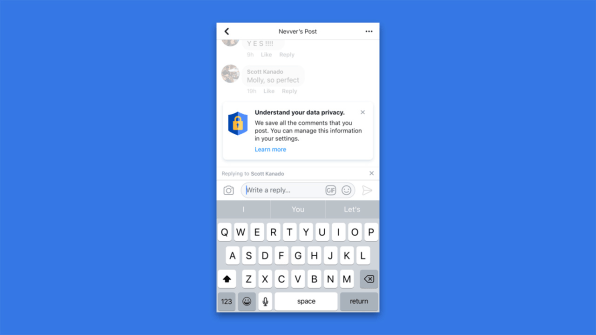 [Image: courtesy NewDealDesign]NDD envisions a simple solution: Remind people that their data is being stored, and where it’s being stored, right on Facebook. When you type in Messenger, a pop-up should come up every now and again explaining that this supposedly private discussion is actually being recorded. It should do the same thing for text and photo posts in your feed.
[Image: courtesy NewDealDesign]NDD envisions a simple solution: Remind people that their data is being stored, and where it’s being stored, right on Facebook. When you type in Messenger, a pop-up should come up every now and again explaining that this supposedly private discussion is actually being recorded. It should do the same thing for text and photo posts in your feed.
“It’s about being transparent, no more legalese,” says Chau. “Break down all the things you do while I use the app, so I’m slowly learning what’s being collected as I use it.”
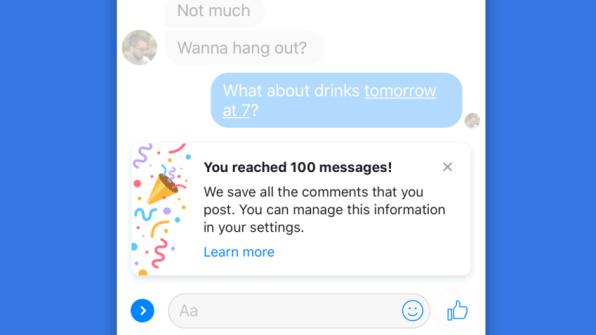 [Image: courtesy NewDealDesign]Truthfully, the most important point of this piece of NDD’s design is not what you see in its design mock-ups here, but the philosophy behind it: Facebook and other services should be slowly and constantly explaining what they do to the user, not having them sign a one-time contract and burying the information in deep settings and legal agreements.
[Image: courtesy NewDealDesign]Truthfully, the most important point of this piece of NDD’s design is not what you see in its design mock-ups here, but the philosophy behind it: Facebook and other services should be slowly and constantly explaining what they do to the user, not having them sign a one-time contract and burying the information in deep settings and legal agreements.
“We don’t want it to happen every single time you use the app, but we want it to remind you,” says Chau.
“A few times a day!” adds Amit, with a laugh.
[Image: courtesy NewDealDesign]
Of course, the subtext to all of this data privacy stuff is not just that we feel violated because corporations see our private lives; it’s that these corporations are making money with our data, too. The user is the product, and they’re being sold to massive advertising networks. And what do we get in return? A free feed of baby photos posted by our friends.
Maybe we wouldn’t care so much if Facebook was more transparent about how our data was being monetized–and if it offered the user a piece of the pie. “Cut me in on the deal,” says Chau. “Show me the money you’ll make off the data, and cut me in.”
 [Image: courtesy NewDealDesign]The team demoed this idea with a coupon for pizza. You see exactly what Facebook is making by showing you that ad–perhaps fractions of a cent. Then, the ad offers you something in return. For example, if you play the video ad, you get 50% off your next pizza order. Both you and Facebook walk away with a financial benefit.
[Image: courtesy NewDealDesign]The team demoed this idea with a coupon for pizza. You see exactly what Facebook is making by showing you that ad–perhaps fractions of a cent. Then, the ad offers you something in return. For example, if you play the video ad, you get 50% off your next pizza order. Both you and Facebook walk away with a financial benefit.
NDD imagines that Facebook could even restructure its ad model entirely to give users a literal piece of the revenue of every ad they see, period. Perhaps this sounds crazy, or like it wouldn’t add up to much money. But Facebook is now making roughly $20 per U.S. user, per quarter. There really is enough money to go around. If Facebook can’t win back the public’s affection, perhaps it can buy it instead.
AI-driven updates, curated by humans and hand-edited for the Prototypr community